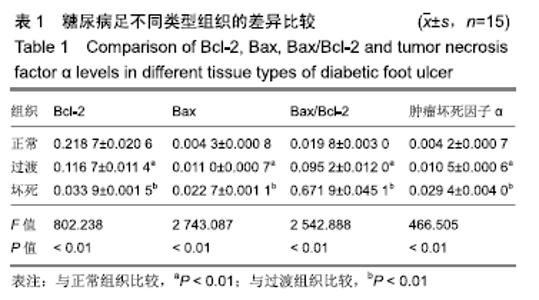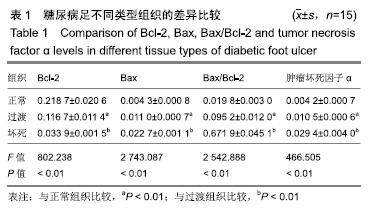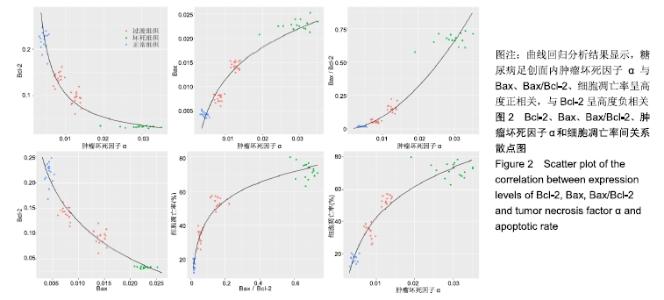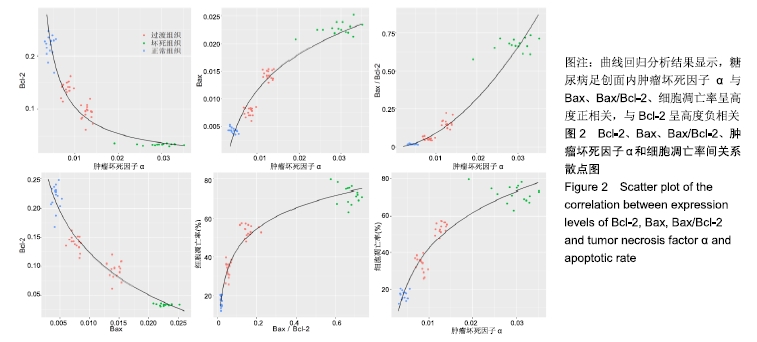[1] 李仕明.糖尿病足与相关并发症的诊治[M].北京:人民卫生出版社,2002.
[2] 中华医学会糖尿病学分会,中华医学会感染病学分会,中华医学会组织修复与再生分会.中国糖尿病足防治指南(2019版)(1)[J].中华糖尿病杂志, 2019,11(2):92-108.
[3] 吕晓玉,王中京.糖尿病足溃疡组织中P物质表达量与氧化应激、细胞凋亡的相关性研究[J].海南医学院学报, 2017,23(18):2503-2506.
[4] CIGNA E, FINO P, ONESTI MG, et al.Diabetic foot infection treatment and care.Int Wound J.2016;13(2):238-242.
[5] ARYA AK, TRIPATHI R, KUMAR S, et al.Recent advances on the association of apoptosis in chronic non healing diabetic wound.World J Diabetes.2014;5(6):756-762.
[6] 向鹏君,季晖,顾铭,等.糖尿病创面的炎症机制研究进展[J].药学研究,2017, 36(11):667-670.
[7] OLSON S.Open fractures of the tibial shaft.Journal of Bone & Joint Surgery-american Volume.1996; 78(46):293.
[8] 付小兵.糖尿病足及其相关慢性难愈合创面的处理[M].2版.北京:人民军医出版社,2013.
[9] 宋春雨,杜联.论糖尿病及糖尿病并发症与细胞凋亡关系[J].辽宁中医药大学学报,2015,17(11):71-73.
[10] 姚颖莎.糖尿病大鼠中细胞凋亡蛋白bax/bcl-2的相关研究进展[J].中外女性健康研究,2016,(1):226-227,211.
[11] 付小兵,蒋礼先,孙同柱,等.3种皮肤慢性溃疡发生与细胞凋亡关系的研究[J].解放军医学杂志,1999,24(5):361-362.
[12] 李峰,林源.Bcl-2 bax及其表达产物与糖尿病难愈性创面细胞凋亡[J].山西医药杂志, 2005,34(12):1015-1017.
[13] 龙艳芳,王新蕾,王明璞,等.雄激素干预成年雄性大脑中动脉阻断模型大鼠脑组织Bcl-2、Bax与Cyt-C的表达[J].中国组织工程研究,2019,23(27): 4344-4349.
[14] 李银苹,张学铭,汪开诚,等.氢分子对高糖状态下肾小球系膜细胞凋亡相关蛋白及Nrf2信号通路的影响[J].中国病理生理杂志, 2018,34(1):29-34.
[15] ÇIL N, OĞUZ EO, METE E, et al. Effects of umbilical cord blood stem cells on healing factors for diabetic foot injuries. Biotech Histochem. 2017;92(1):15-28.
[16] YUAN J, CHEN M, XU Q, et al. Effect of the diabetic environment on the expression of MiRNAs in endothelial cells:Mir-149-5p restoration ameliorates the high glucose-induced expression of TNF-αand ER stress markers.Cell Physiol Biochem.2017;43(1):120-135.
[17] OLTVAI ZN, MILLIMAN CL, KORSMEYER SJ.bcl-2 Heterodimerizes in vivo with a Conserved Homolog, Bax, That Accelerates Programed Cell Death.Cell. 1993;74(4):609-619.
[18] 陈聪,陈云志,喻嵘,等.中医药调控糖尿病常见并发症bax表达的实验研究述评[J].天津中医药大学学报,2017,36(2):81-84.
[19] 陈伟,付小兵,孙同柱,等.皮肤溃疡伤口中Bax和Bcl-2蛋白含量的变化及其与溃疡发生的关系[J].现代康复,2001,5(12):54-55.
[20] OLIVEIRA BV, BARROS SILVA PG, NOJOSA JDE S, et al. TNF-alpha expression, evaluation of collagen, and TUNEL of Matricaria recutita L. extract and triamcinolone on oral ulcer in diabetic rats.J Appl Oral Sci. 2016;24(3):278-290.
[21] KASIEWICZ LN, WHITEHEAD KA. Lipid nanoparticles silence tumor necrosis factor α to improve wound healing in diabetic mice.Bioeng Transl Med.2019;4(1):75-82.
[22] 成军.现代细胞凋亡分子生物学[M].3版.北京:科学出版社,2017.
[23] 刘铭,刘欣伟,刘宪民,等.TNF-α、Caspase-3在大鼠脊髓损伤后神经细胞凋亡中相关性研究[J].临床军医杂志, 2017,45(4):366-370.
[24] SCHNEIDER-BRACHERT W, TCHIKOV V, NEUMEYER J, et al. Compartmentalization of TNF receptor 1 signaling: internalized TNF receptosomes as death signaling vesicles.Immunity.2004; 21(3): 415-428.
|



